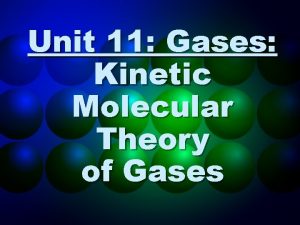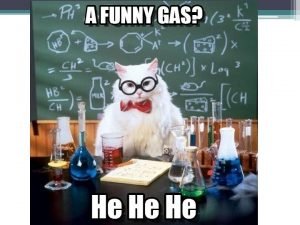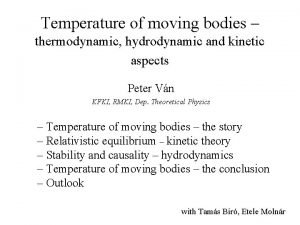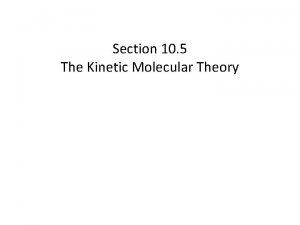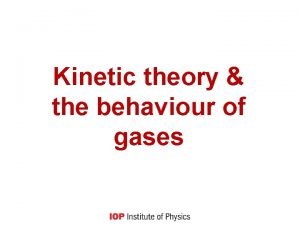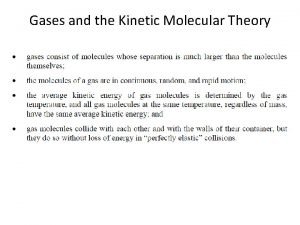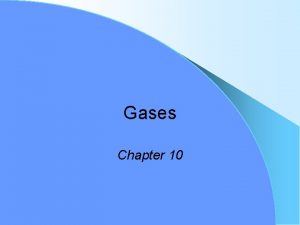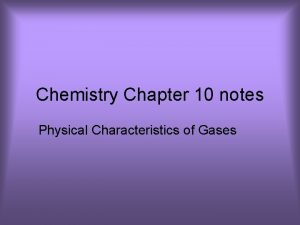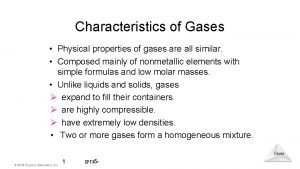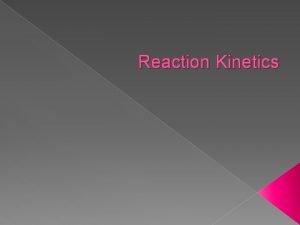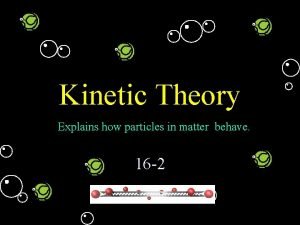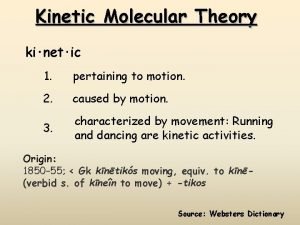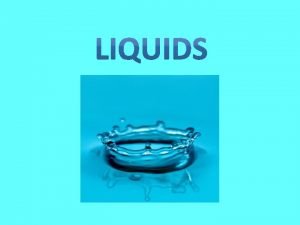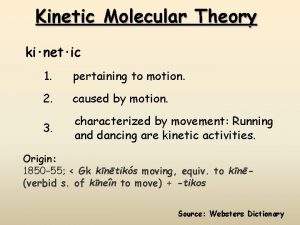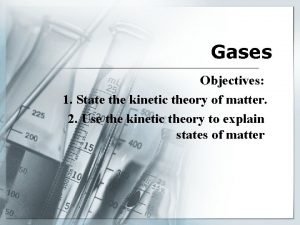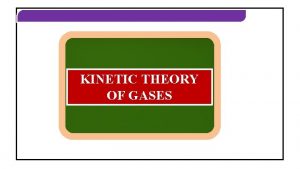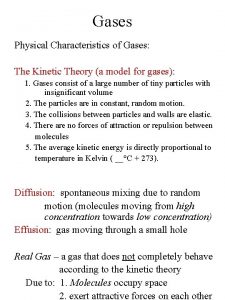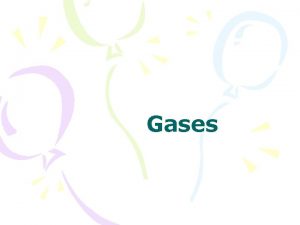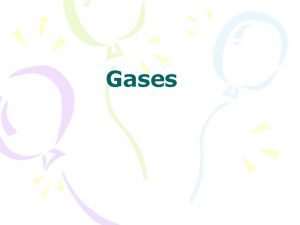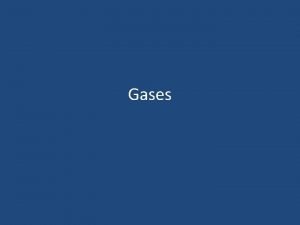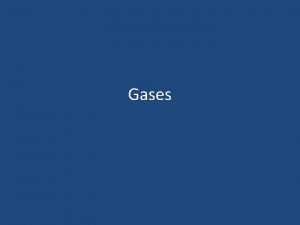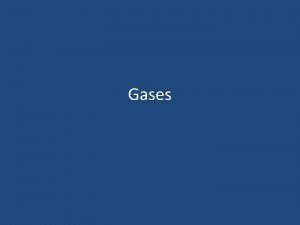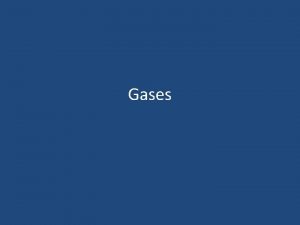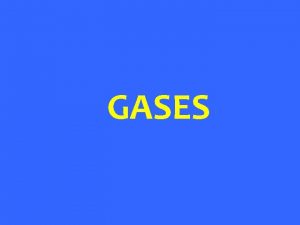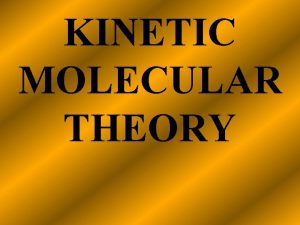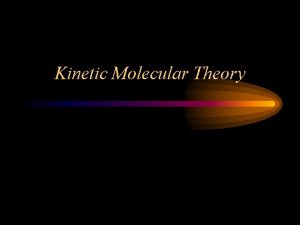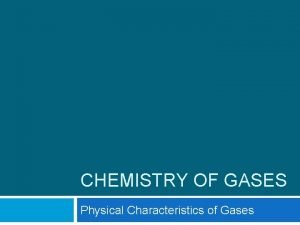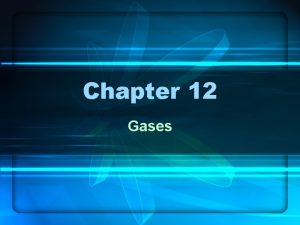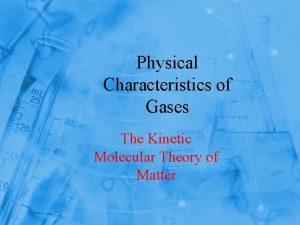Gases Physical Characteristics of Gases The Kinetic Theory






















- Slides: 22

Gases Physical Characteristics of Gases: The Kinetic Theory (a model for gases): 1. Gases consist of a large number of tiny particles with insignificant volume 2. The particles are in constant, random motion. 3. The collisions between particles and walls are elastic. 4. There are no forces of attraction or repulsion between molecules 5. The average kinetic energy is directly proportional to temperature in Kelvin ( __°C + 273). Diffusion: spontaneous mixing due to random motion (molecules moving from high concentration towards low concentration) Effusion: gas moving through a small hole Real Gas – a gas that does not completely behave according to the kinetic theory Due to: 1. Molecules occupy space 2. exert attractive forces on each other

SOLID LIQUID GAS Has its own shape Takes shape Fills of container Highest density Middle density Lowest density Not Compressible compressible Little movement Some movement Rapid movement

Properties (P, V, T, n) • Pressure (P): force that a gas exerts on a given area • 1 atm = 760 torr = 760 mm. Hg • Volume (V): space occupied by gas • 1 L = 1000 m. L = 1000 cm 3 • Temperature (T): measure of the average kinetic energy of the gas • MUST be in Kelvin! • K = ˚C + 273 • Number of moles (n): quantity of gas molecules

What is Pressure? • Changing the force or area will change the pressure (shoes!) • Atmospheric (air) pressure is measured by a barometer: vacuum mercury atmospheric pressure • 1 atm = 760 torr = 760 mm. Hg =1. 013 x 105 Pa =101. 3 k. Pa • STP: standard temperature and pressure. 1 atm and 0ºC

Boyle’s Law ·When T is constant: inverse relationship between P and V (one goes up… the other goes down) ·A sample of oxygen gas occupies a volume of 20 m. L at 2. 0 atm. At what pressure will it occupy 55 m. L?

Charles’s Law ·When P is constant: direct relationship between V and T (one goes up… the other goes up)

·You get a 1. 7 L balloon inside at a temperature of 23˚C. At what temperature will the volume drop to 1. 5 L ? ·Convert initial temperature to K T 1 = ˚C + 273 = 23 + 273 = 296 K ·Rearrange equation ·Solve for final temperature ·How cold is that? !? !

Gay-Lussac’s Law þWhen V is constant: direct relationship between P and T (one goes up… the other goes up) þHigher T: more collisions in same area. þA fire extinguisher has CO 2 at 22ºC and 20 atm. What is the pressure at 30ºC?

Practice! • First 3 “Worksheets”

Combined Gas Law • True when moles are constant • Use to remember – Boyle’s law: – Charles’s law: – Gay-Lussac’s law: • A balloon has a volume of 20. 0 L at 23ºC and 770 torr. What will its volume be at 685 torr and 25ºC?

Ideal Gas Law PV=n. RT • R is the gas constant. It will always have the same values. • You must know which one to use • R = 8. 314 k. Pa L K-1 mol-1 if Pressure is in kilopascals(k. Pa), Volume is in liters(L), Temperature is in Kelvin(K) R = 0. 0821 L atm K-1 mol-1 if Pressure is in atmospheres(atm), Volume is in litrers(L), Temperature is in Kelvin(K)

Ideal Gas Law • What volume is needed to store 0. 050 moles of helium gas at 202. 6 k. Pa and 400 K? • What pressure will be exerted by 20. 16 g hydrogen gas in a 7. 5 L cylinder at 20ºC? • A 50 L cylinder is filled with argon gas to a pressure of 10130. 0 k. Pa at 30ºC. How many moles of argon gas are in the cylinder? • To what temperature does a 250 m. L cylinder containing 0. 40 g helium gas need to be cooled in order for the pressure to be 253. 25 k. Pa?

Dalton’s Law of Partial Pressure • The total pressure of a gas sample is equal to the sum of the partial pressures of individual gases. • Example: Earth’s atmosphere Gas Pressure (torr) N 2 593. 5 O 2 159. 2 Ar 7. 1 CO 2 0. 23 Total 760

93. 4 k. Pa 3. 3 k. Pa

Gases You Know ·N 2 ·The most common gas in our atmosphere (78%) ·Not reactive ·O 2 · 20% of the atmosphere ·Supports combustion ·CO 2 ·Greenhouse gas ·More dense than air ·Used in fire extinguishers ·H 2 ·Very low density ·Explosive if mixed with O 2

P T V Boyle’s Law P T Charles’s Law V

Vapor Pressure and Boiling • Vapor Pressure – the pressure exerted by a vapor in equilibrium with its liquid state. • Liquid molecules at the surface escape into the gas phase. • These gas particles create pressure above the liquid in a closed container. Vapor Pressure Explained (Vid)

The condition in which two opposing processes are occurring simultaneously at equal rates is called a dynamic equilibrium. A liquid and its vapor are in equilibrium when evaporation and condensation occur at equal rates. This can only be obtained in a closed container.

• Vapor Pressure increases with increasing temperature. 20 o. C 80 o. C • As temperature increases, the amount of vapor generated by a liquid in a closed container increases. • This occurs because as the liquid gains kinetic energy, the molecules can overcome the

Evaporation vs Boiling • Evaporation - when a liquid gas at any temperature • Vaporization – When a liquid gas when heat is applied or at the boiling temperature • Boiling – occurs when the vapor pressure above the liquid equals the atmospheric pressure.

Vapor Pressure Curves Graph shows how boiling points change with change in vapor pressure.

Boiling Points change with pressure changes. • Less pressure = lower boiling point temperature (example = water boils at lower temperatures at high elevations- water boils at 76 o. C on Mt. Everest). • Higher Pressure = higher boiling point temperature (example = pressure cooker – cooks
 Kinetic molecular theory
Kinetic molecular theory Particle theory freezing
Particle theory freezing Kinetic theory of gases
Kinetic theory of gases Three postulates of kinetic theory of gases
Three postulates of kinetic theory of gases Kinetic theory of gases
Kinetic theory of gases Postulates of kinetic theory of gases
Postulates of kinetic theory of gases Postulates of kinetic theory of gases
Postulates of kinetic theory of gases Kinetic theory
Kinetic theory Physical characteristics of gases
Physical characteristics of gases Physical characteristics of gases
Physical characteristics of gases Physical characteristics of gases
Physical characteristics of gases Characteristics of gases
Characteristics of gases Chapter 14 solids liquids and gases
Chapter 14 solids liquids and gases The kinetic theory of matter states that
The kinetic theory of matter states that Kinetic theory of matter definition
Kinetic theory of matter definition Kinetic theory of matter
Kinetic theory of matter The kinetic theory explains how particles in matter behave
The kinetic theory explains how particles in matter behave The kinetic molecular theory
The kinetic molecular theory Adhesive force
Adhesive force Kinetic molecular theory of liquids
Kinetic molecular theory of liquids Kinetic energy molecular theory
Kinetic energy molecular theory Kinetic theory def
Kinetic theory def Kinetic molecular theory timeline
Kinetic molecular theory timeline


